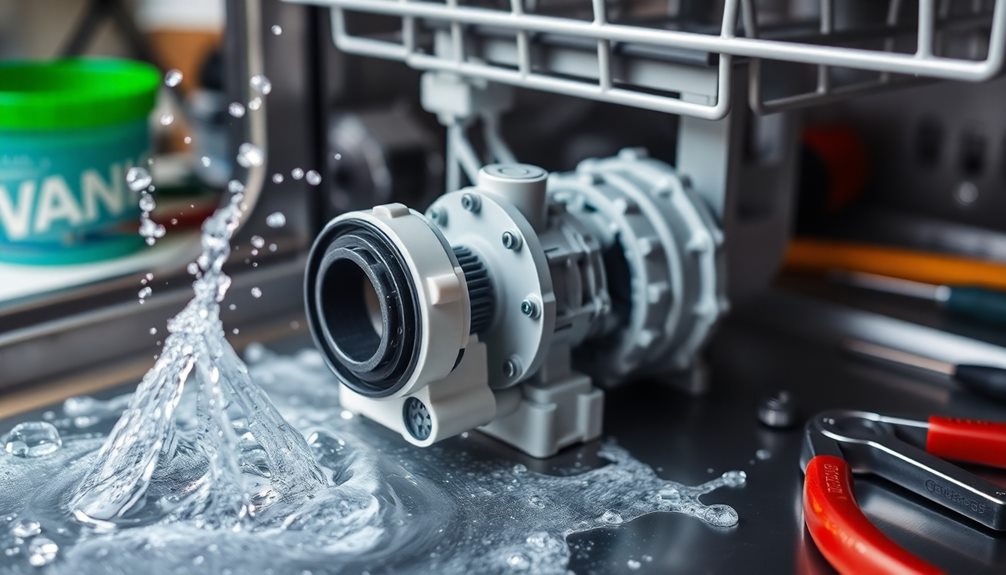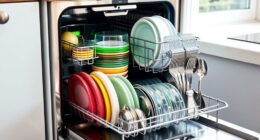If your dishwasher pump isn't working, don't panic. Start by checking for standing water, which indicates drain pump problems. Listen for unusual noises; those could mean a malfunctioning pump motor. Inspect for blockages in the drain line or pump, as clogs can prevent proper drainage. Test the pump motor with a multimeter for continuity; if there's none, you'll need a replacement. Also, check the drain impeller and solenoid for any damage. Regular maintenance, like cleaning filters, can help prevent future issues. There's plenty more you can do to guarantee your dishwasher runs smoothly!
Key Takeaways
- Inspect the drain pump for blockages that may hinder water flow and cause drainage issues.
- Use a multimeter to check the drain pump motor for continuity; replace if there's no continuity.
- Examine the drain impeller for damage or clogs, as a broken impeller can obstruct water movement.
- Ensure the drain solenoid opens the drain valve properly; replace if it fails to function.
- Regularly clean the dishwasher filter and drain components to prevent clogs and maintain optimal performance.
Common Symptoms of Pump Failure
When your dishwasher pump starts to fail, you might notice several key symptoms that indicate trouble. One of the most obvious signs is standing water at the bottom of your unit after a wash cycle. This often occurs when the drain pump motor isn't functioning properly, leading to pump failure.
You may also hear unusual noises, like humming or grinding, which can signal a malfunction in the pump motor. If you notice your dishwasher isn't draining, it might be due to a power issue. Check the control board to verify it's sending power to the drain pump.
Another common culprit is a broken drain impeller, which can block water movement and require immediate replacement to restore proper function. To further investigate, perform a continuity test on the drain pump. Using a multimeter, you can confirm if the motor is functional; a lack of continuity typically indicates pump failure.
Don't overlook the drain valve either, as a stuck or damaged valve can contribute to drainage issues as well. Addressing these symptoms promptly can save you from more extensive repairs down the line.
Key Troubleshooting Steps
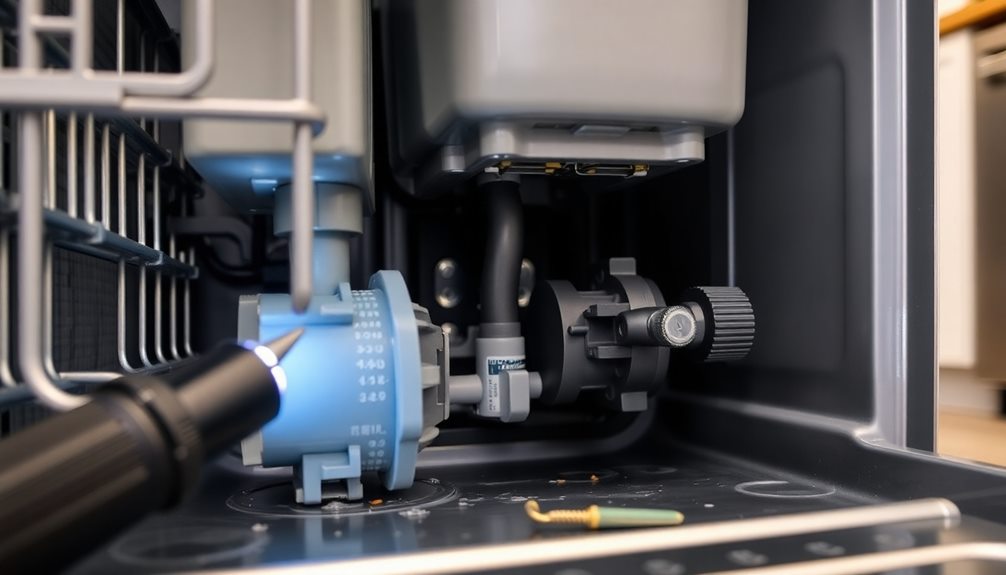
Before diving into repairs, you should start by identifying any potential blockages in the drain pump.
Begin by inspecting the pump and ensuring that the impeller is intact and functioning correctly. A broken impeller can hinder water movement, resulting in drainage issues.
Next, use a multimeter to test the drain pump motor for continuity; if it shows no continuity, you'll need to replace the pump, as drain pumps aren't repairable.
Don't forget to check the drain solenoid, too. If it fails to open the drain valve, it'll prevent the water from draining properly, necessitating a replacement.
While you're at it, verify that the dishwasher control board is supplying power to the drain pump, as a malfunctioning control board can stop the pump from operating during the drain cycle.
Possible Causes of Issues

If your dishwasher isn't draining, a drain pump malfunction might be the culprit.
You should also check for clogged drain components, as debris can easily block water flow.
Identifying these issues early can save you time and hassle in repairs.
Drain Pump Malfunction
A malfunctioning drain pump can lead to significant frustration, especially when your dishwasher fails to drain properly. The drain pump is essential for pushing water through the drain hose, and if it's defective, you'll notice standing water in the bottom of your machine.
Start by checking the drain pump motor. Use a multimeter to test for continuity; if it lacks continuity or doesn't run when powered, you'll need to replace it entirely.
Next, inspect the impeller inside the pump. If it's damaged or clogged, it won't effectively move water, which could also be the reason for drainage issues. A broken impeller should be replaced immediately to restore functionality.
Additionally, clogged filters in the sump assembly can lead to low water flow, impacting the drain pump's performance.
Be certain to check the drain hose for any blockages that could prevent water from exiting your dishwasher. If you find any clogs, clear them out to guarantee proper drainage.
Clogged Drain Components
When your dishwasher struggles to drain effectively, clogged drain components could be the culprit. It's crucial to inspect and maintain these parts regularly to guarantee peak performance.
| Component | Description | Action Required |
|---|---|---|
| Sump Filter | Clogged with debris can hinder water flow | Clean with soap and warm water |
| Drain Solenoid | Opens the drain valve for water exit | Replace if it fails |
| Drain Impeller | Pushes water during drainage | Check for damage or clogging |
Start by verifying that the drain valve is clear of debris. If the drain pump or hose is blocked, you'll need to inspect and possibly replace them. Don't forget to check the pump motor to see if it's functioning properly. If the drain solenoid fails, it won't open, preventing drainage altogether. In some cases, you may need to replace the drain pump entirely. Regular checks of the drain impeller are also recommended; a broken impeller can greatly impede the water movement, guaranteeing that water drains effectively. By addressing these issues, you'll keep your dishwasher running smoothly.
Effective Solutions to Try
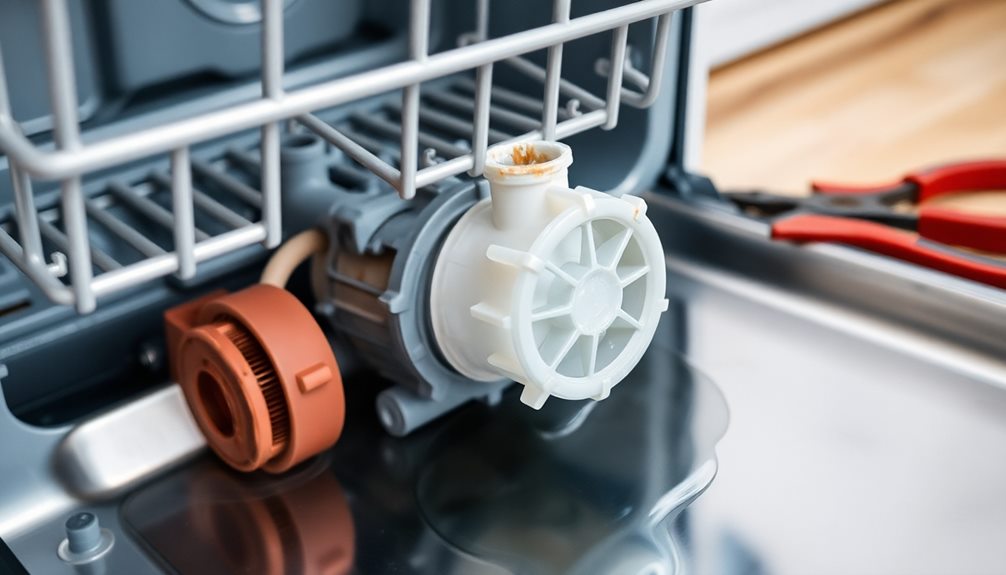
Before diving into repairs, start by checking for blockages in the drain line and pump, as these could be the culprits behind your dishwasher's issues. A clogged dishwasher can prevent water from flowing properly, so it's crucial to inspect the drain and remove any debris.
Next, test the drain pump motor for continuity using a multimeter. If you find there's no continuity, it means the pump is non-repairable and needs replacement.
While you're at it, inspect the drain impeller for any damage; a broken impeller can seriously hinder water movement, necessitating immediate replacement.
Don't forget to check the drain solenoid as well. If it fails to open the drain valve, your dishwasher won't drain, and you'll need to replace it to restore functionality.
Regularly cleaning the sump filters is another proactive approach; clogged filters can lead to low water flow and poor washability, contributing further to pump issues.
User Experiences and Insights
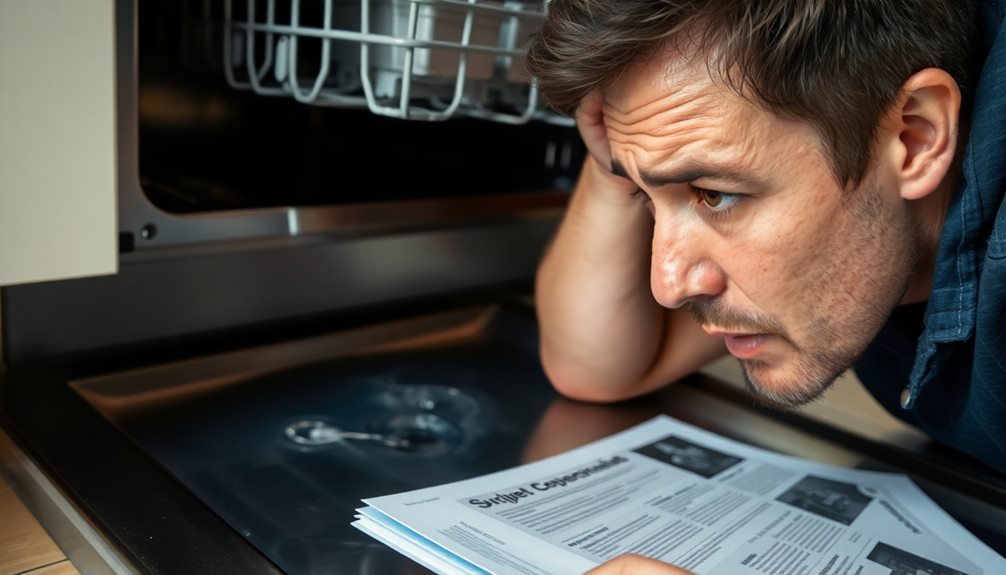
You've probably dealt with your share of common pump issues and felt the frustration of temporary fixes that just don't last.
Sourcing replacement parts can be a real headache, often extending your repair time when you least need it.
Many users share your experience, turning to DIY solutions and community tips to tackle these challenges head-on.
Common Pump Issues
A malfunctioning drain pump can turn a simple dishwashing task into a frustrating ordeal. Many users report that when their dishwasher isn't draining, standing water becomes a common sight after cycles. Often, the culprit is a faulty drain pump, which may be hindered by debris or a malfunctioning motor.
When you notice issues, check the drain valve and impeller; these components can be repairable if they're obstructed or stuck. Some users have found temporary relief by tapping the motor to free stuck parts, suggesting a potential mechanical failure that mightn't require a full replacement.
However, you should know that replacing the drain pump doesn't always solve the problem. Many have gone through the hassle only to find the issue persists, leading them to contemplate buying a new dishwasher altogether.
Frustration mounts when sourcing replacement parts and schematics proves difficult, especially for specific dishwasher models. With a growing interest in DIY solutions, over 25,000 views on troubleshooting content indicate that you're not alone.
Understanding these common pump issues can empower you to tackle your dishwasher's problems more effectively.
Temporary Fixes Identified
Many users facing dishwasher pump issues have found temporary fixes that alleviate their frustrations, at least for a while. One common method involves tapping the drain pump gently to free any stuck components. This quick fix can sometimes get the water from draining again, but it won't last forever.
Some Kenmore dishwasher owners have shared their experiences online, highlighting the significance of diagnosing the problem first. Running your dishwasher in diagnostic mode may reveal error codes that point toward the underlying issue. Additionally, understanding the financial implications of repairs or replacements can be essential, as investing in a new appliance can sometimes be more cost-effective in the long run, especially when considering investment strategies.
Another strategy includes checking the drain valve. If it's improperly installed or clogged, you might need to clean out the valve to guarantee smooth operation.
While some users have resorted to using RTV sealant on pump components as a temporary fix, this can lead to further complications down the line. Remember, these are merely stopgap solutions.
If you keep experiencing issues, it's worth considering whether the pump is repairable or if investing in a new dishwasher is the better option. Temporary fixes can help in a pinch, but they often highlight deeper problems that need addressing.
Part Sourcing Challenges
While trying to repair your dishwasher, you might find that sourcing replacement parts poses significant challenges, particularly for older models. Users often report extended downtime and frustration when searching for compatible parts, especially for components like the drain pump or drain valve.
- Lack of clear schematics makes it tough to identify repairable components.
- Supply chain issues can delay delivery times, leaving you without a functioning dishwasher.
- Online forums are a popular resource for finding compatible parts, yet the information can be inconsistent.
To overcome these challenges, start by checking your dishwasher's model number and cross-reference it with part numbers online.
If you're troubleshooting, use a multimeter to check continuity in the drain pump and other components. This can help you ascertain whether the part needs replacement or if the issue lies elsewhere, like the garbage disposal.
Preventative Measures for Clogs
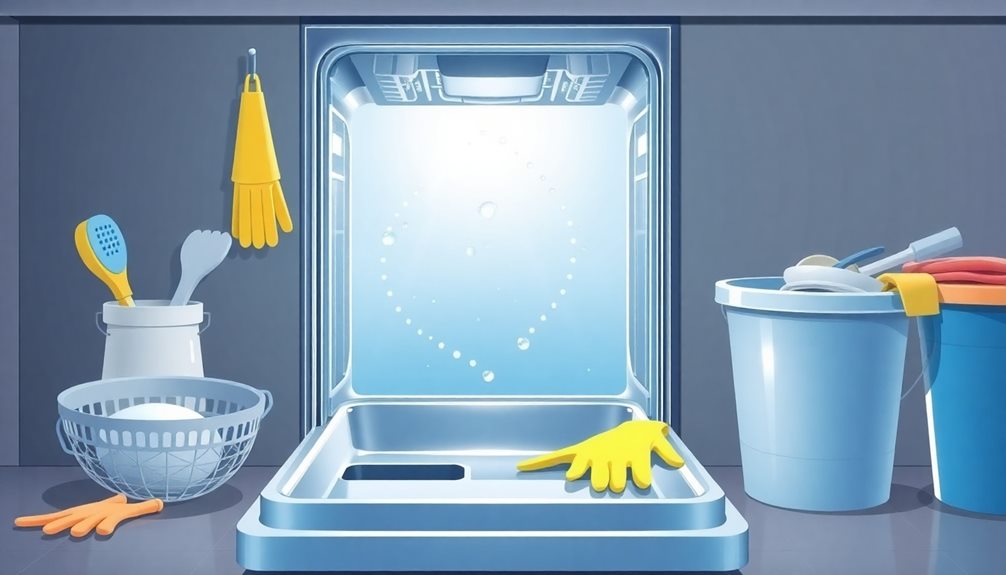
Preventing clogs in your dishwasher is vital for maintaining its efficiency and longevity. Start by regularly scraping off food particles from your dishes before loading them. This simple step minimizes the risk of clogs in the drain system.
It's also important to clean the dishwasher filter monthly; a dirty filter can cause food particles to accumulate and obstruct water flow, potentially damaging the drain pump.
Proper loading of dishes is another key factor. Avoid overloading, and make sure that the spray arms can rotate freely. This prevents blockages that could hinder performance.
Additionally, using high-quality dishwasher detergent helps prevent soap buildup, which can contribute to clogs and drainage issues.
Before you start your dishwasher, run hot water in the sink. This helps emulsify grease and food residues, making it easier for them to flow through the drain valve and preventing water from backing up.
Supplies Needed for Repairs

When tackling dishwasher pump repairs, having the right supplies on hand streamlines the process and guarantees you're prepared for any issues.
Here's a quick list of essential items you'll need:
- Multimeter: To test the continuity and voltage of the drain pump motor and other electrical components.
- Screwdriver set: For removing screws that secure components like filters and the drain pump itself.
- Bucket: To collect any standing water when accessing the dishwasher's internal parts.
Additionally, keep some towels or rags nearby to soak up residual water and prevent spills.
As you work on the dishwasher, you might encounter clogged filters; having a soft brush, like an old toothbrush, can help clean these effectively.
Using a multimeter will be vital for checking the drain pump's motor, ensuring everything is functioning properly.
With these supplies, you'll be well-equipped to inspect and replace any faulty components in your dishwasher, making the repair process smoother and more efficient.
Additional Resources and Support

Having access to the right resources can make all the difference in successfully repairing your dishwasher. If your drain pump isn't working, you may need to determine if the solenoid opens the drain properly or if the drain valve is defective.
Whirlpool offers a variety of articles and guides that can help you troubleshoot these issues.
If you find that the problem is more complex and you can't fix it yourself, don't hesitate to schedule a service appointment by calling 1-800-253-1301. Their professionals can assist you in determining whether the issue is repairable or if you need to remove the dishwasher for a more thorough inspection.
Additionally, online forums and communities focusing on appliance repairs can be valuable. You can gain insights, share experiences, and even find help finding specific solutions to your dishwasher problems.
Consider investing in a home warranty plan that covers major appliances, including dishwashers, to protect against unexpected repair costs. This can make the repair process simpler and less stressful, ensuring your dishwasher can properly drain and function as intended.
Frequently Asked Questions
How to Tell if a Pump Is Bad on a Dishwasher?
To tell if a pump's bad, listen for unusual noises like humming, check for physical damage or blockages, and perform a continuity test with a multimeter. No continuity likely means it needs replacement.
Why Is My Dishwasher Not Pumping Water In?
Like a car running on empty, your dishwasher might not pump water due to a clogged filter, a kinked hose, or a faulty drain solenoid. Check these issues to restore its flow and functionality.
How Much Does It Cost to Fix a Dishwasher Circulation Pump?
Fixing a dishwasher circulation pump typically costs between $150 and $400, depending on labor and parts. If you're handy, consider DIY options, which range from $50 to $200 for the replacement pump alone.
How to Unblock a Dishwasher Pump?
Picture a waterfall, flowing freely—your dishwasher should feel that way too. To unblock the pump, first clear debris from the filter and impeller, then check hoses for kinks. Let the water flow effortlessly again!
Conclusion
To summarize, tackling a dishwasher pump issue isn't just about fixing a machine; it's about restoring convenience in your kitchen. Did you know that a well-maintained dishwasher can save you up to 230 hours a year compared to hand washing? By following the troubleshooting steps and preventative measures outlined, you can prolong your appliance's life and avoid costly repairs. Stay proactive, and you'll keep your dishwasher running smoothly for years to come.
